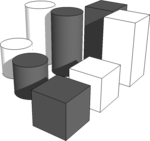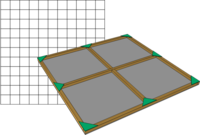Hnefetafi Game
From DT Online

Description
Vikings played a board game called Hnefetafi. This chess-like game had twenty-four ‘white’ pieces and thirteen ‘black’ pieces. One of the black pieces was the ‘king’ and was bigger than the others. A typical board had 169 (13 x 13) or 121 squares (11 x 11), some of which where decorated
Playing the Game
The game starts with the 24 white pieces on the patterned squares around the edge of the board and the 13 black pieces on the patterned squares in the middle of the board. The ‘king’ is placed on the middle square with the other black pieces around it.
The object of the game is for the player with the black pieces to reach one of the corner squares with the ‘king’, the player with the white pieces tries to capture the ‘king’ or stop it reaching the corner.
Black and white move in turn, each piece can move forwards, backwards or side wards (but not diagonally) and can move as many
squares as the player wishes as long as there is no other piece in the way. Enemy pieces can be captured by ‘sandwiching’ them between the two pieces (i.e. one on either side of a straight line) they are then removed from the board. White pieces cannot occupy the corner squares (shown in white).

Making the Game
Start with a large square of card or some other sheet material such as MDF. Draw the grid (11 squares x 11 squares) with a felt-tip pen. (Ruler width strips are probably easiest : the board would be approximately 32cm x 32cm if a standard wooden ruler is used).
Design a pattern for the patterned squares (e.g. look in books or on the internet for a suitable ‘Viking’ image). A typical Hnefetafi layout is shown.

You need two different patterns: one for the middle square and one for the others. (Don’t make the main pattern too complicated - you need to decorate 36 of the squares with it!).
Note: You could draw the pattern using the computer and then copy it 35 times, print it out, cut out the squares and then stick them onto the board . . . or you could design and whole playing surface this way and paste it on to your board
The Playing Pieces

You will need 24 light coloured pieces and 12 dark pieces of approximately the same size & one larger dark coloured piece.
The pieces should have a simple flat-bottomed shape and could be made from clay, ‘found’ materials (e.g. beads or buttons), or commercially available Wood Draught & Backgammon Pieces can be used (stick two or three together to make the ‘king’).
Alternatively, Playing Pieces can be sawn from lengths of 20mm square Softwood, 20mm diameter Dowel or plastics tubing using a Precision Mitre Saw.
Further Work

If required, the game board can be stiffened with an underframe using Stripwood Technology techniques to join together strips of softwood using cardboard triangles.
Additionally, the Game Board can be made to fold in two by hinging it down the centre so that both it and the Playing Pieces can be fitted into a Storage Box.









